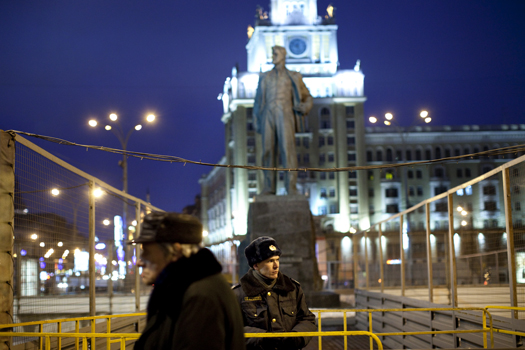
A police officer stands in front of a blocked off Triumfalnaya Square ahead of the arrival of protesters on New Year’s Eve in Moscow, Russia. Opposition protesters, organized by Strategia-31, planned to gather in Triumfalnaya Square on New Year’s Eve as part of their monthly protest but arrived to find it closed and surrounded by police.
I can’t say I wasn’t warned. Running toward the escalator at the Mayakovskaya metro station, I glimpsed a familiar face out of the corner of my eye. It might be more correct to say that I spotted a familiar figure: an elderly woman in a fur hat, leaning on her walker, surveying the station from a bench. Her picture had appeared in a number of news articles about last week’s protests (including my own). “Do you know you’re all over the Western media?” I asked the woman. She leaned in to hear better, her white protest ribbon and her World War II decorations intertwined. Her eyes widened with surprise, then pleasure. We chatted. “I’ve already been to the protest today,” she said, “but I’m not going back. It’s full of police.” Someone might get killed, she thought, if not by the police, then because the law enforcement would be distracted by the protesters.
Half an hour later I was being pushed down the street by a line of riot police who were attempting to clear the sidewalk. As I tried to squeeze into the wall of people, a helmeted officer edged me forward with his elbow. “Let’s go, let’s go,” he instructed me impatiently. As the shoving subsided, I found myself pushed up against another line of policemen. I could not see any protesters around me; it was all journalists, cameras flashing and rolling. I made my way back up the street, climbing up a few steps toward the door of a fast food joint to get a better view. As I settled into my new position, surveying the crowd, I was startled by a walkie-talkie going off next to me. It turned out the people I had assumed to be passersby or fellow observers seeking a better vantage point were plainclothes police.
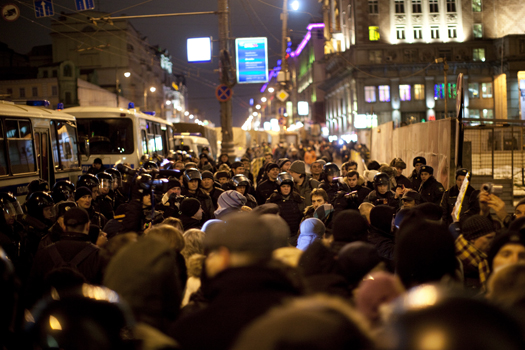
Protesters and journalists face off with police on the street near Triumfalnaya Square.
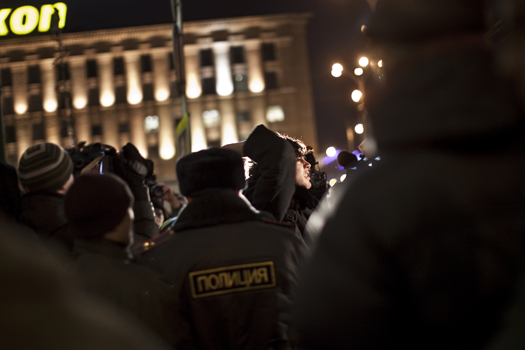
A protester is moved to a police bus after being arrested.
The atmosphere was pregnant with anticipation. A couple protesters had been pushed into awaiting police buses. The arrests were amazingly swift: an opposition member would wave a banner or shout a political slogan (mostly in support of Taisia Osipova, an activist who was sentenced to ten years of prison for alleged drug trafficking this week); a few riot police would surround him or her, pushing them toward the bus; the press would follow, blinding flashes in their wake; the police would frisk the activists in a split second, and then the arrested would disappear into the bus, pulled in by the well-trained arms inside.
As I was looking over the scene, another sweep of the street was starting. A group of young riot policemen—they seemed to be in their early twenties, some shy and others seemingly emotionless—were preparing for the march. As they awaited orders, one picked his teeth, despite photojournalists taking pictures all around him; another smiled slyly and waved toward where I stood. A woman in her sixties, with perfect grey curls and a sparkly beret, rushed past the police and toward the metro.

A pedestrian walks through a group of police organizing a line to push protesters off the sidewalk.
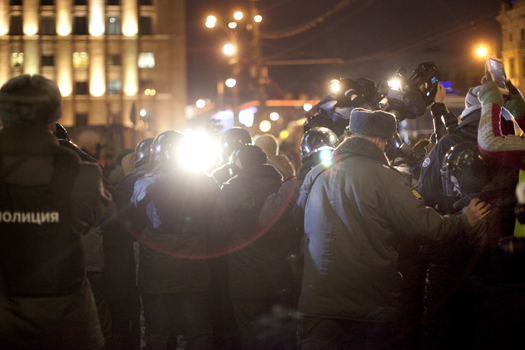
Police push back protestors and journalists, in an effort to keep the sidewalks clear for pedestrians.
This time, the police did not overlook those perched on the fast food restaurant’s stoop. Two cameramen, one holding the other, were separated and pushed down, hard; I raised my arms in the air, hoping to avoid the rough treatment. The policeman barely looked at me, but spared me the push-and-pull. In the meantime, the officer leading the charge screamed, “Do not hurry!” to his subordinates.
By the police barricade where I ended up, things were relatively calm. Journalists were debating the number of those arrested. (Twenty-one seemed to be the final consensus.) At the protest as a whole, the number of reporters far exceeded the number of activists; the former were, in turn, significantly outnumbered by the police, who had cordoned off the Triumfalnaya Square where the demonstration was supposed to be held, and who lined the streets around it. The police were asking the “dear citizens” to clear the street for traffic and move along. “Everyone is walking just fine—relax!” an activist shouted while walking by the barricades. “This event is not sanctioned by the government,” was the refrain of the omnipresent loudspeaker announcements.

Pedestrians, many dressed up and carrying gifts on their way to New Year’s Eve parties, make their way through the crowd of police and protesters.

Two men, one wearing a button for the group Strategia-31, watch from a distance as protesters struggle with police. Both men were arrested at a protest on December 5 and feared rearrest.
The protest was, indeed, one of a series never approved by the government. It was coordinated by a group that calls itself Strategia-31, in honor of the thirty-first article of the Russian constitution that mandates the right to free and peaceful assembly. Strategia-31 largely consists of nationalist Bolsheviks, whose party, headed by the infamous writer Eduard Limonov, has been outlawed in Russia since 2007. This particular demonstration, though, was dedicated to Taisia Osipova, and many thought that it might turn out to be better-attended and more politically diverse than previous Strategia-31 events, following so closely on the heels of two large and peaceful protests. While the police arrested most of those actively protesting—those screaming “Russia will be free” and “Freedom for Taisia Osipova” or waving large banners, including one that proclaimed DEATH TO THE KREMLIN OCCUPIERS—they did not seem interested in being overzealous. A group of women in their sixties holding anti-Putin banners was never bothered by the law enforcement; they gave interviews and chanted freely, to the surprise of passersby, many of whom were trying to get to concerts and New Year’s parties.
Much, if not most, of the protest turned into a game of cat-and-mouse between the police on the one side and the activists and media on the other. Streets and crosswalks would be blocked off, then reopened; the crowd would be directed to the right, then to the left. Thanks to the constant nudging of the riot police, the demonstration proceeded farther and farther away from its original location, until finally only a group of about fifty people was left. They, too, were quickly separated and dispersed. As a few dozen activists and journalists lingered, wondering whether this was really the end of the protest (barely an hour and a half after it got started) a loudspeaker announcement came on. “The event is over,” the policeman said. “The event is over,” he repeated, and then added, “It is time for us to set our dinner tables.” He then wished everyone a Happy New Year, sounding a little taunting.

“It is time for us to set our dinner tables,” an officer called into a bullhorn, as police dispersed protesters and journalists.
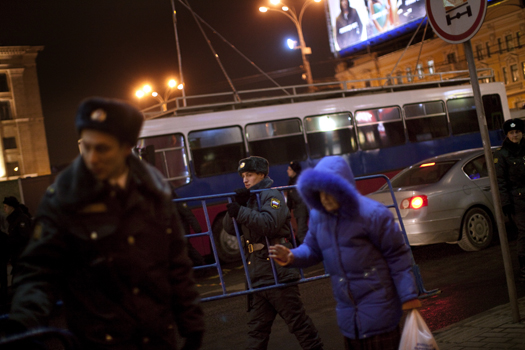
Police remove barriers from Triumfalnaya Square after the protest on New Year’s Eve.
Next to the metro, where the remaining crowd was directed, a group of policemen were joking around. One was petting a German shepherd, who seemed completely placated by the officer’s touch. Searching his pockets for a treat, the policeman finally offered the dog some gum.






